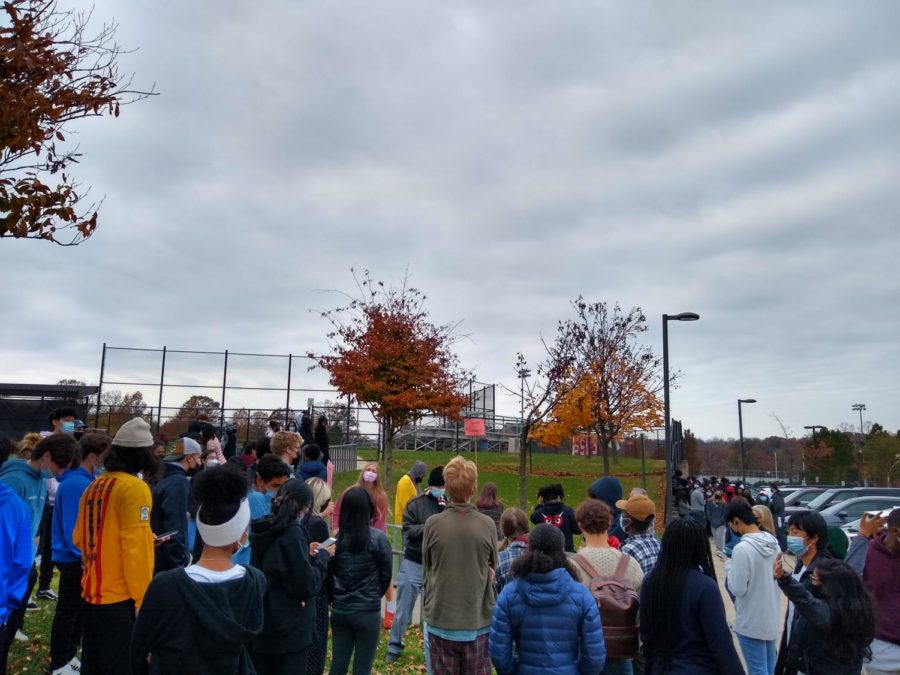School safety drills prepare students for the worst emergencies
Students huddle together during a fire drill.
December 14, 2021
Screams of “get down!” run adjacent with each gunshot ringing throughout the area. Dashing for cover while attempting to grasp the situation at hand. Questions like whether or not they will see their family flood their mind. This is no warzone, rather a Littleton Colorado high school where hundreds of students once felt safe.
Two decades since the 1999 Columbine high school shooting, footsteps echo through silent hallways everyday, shaking at knobs while students huddle in the corner of a dark classroom. An announcement over the intercom: a cheerful voice calling for another successful lockdown drill signals students and staff to proceed with their day as if nothing happened other than a spontaneous five minute break from school.
With in-person school back in session after a year and a half hiatus at Richard Montgomery, both shelter in place and lockdown drills come with it. No doubt these drills are paramount for the real deal. However, they do come with many caveats and drawbacks, not being as effective as many think of them to be.
The history of lock down drills go back to the aftermath of the Columbine shooting, the first major shooting with massive news coverage. The nation watched horrified as Eric Harris and Dylan Klebold murdered 12 of their classmates. In response to the tragedy, a school safety movement sparked. However, a few were inspired to carry out the same as seen in the 2005 Minnesota Red Lake high school shooting. When a rise in mental illness intersects with a copycat mentality, a school shooting epidemic is created.
Lockdown drills at the very least provide for a rigid procedure meant to keep order in a chaotic situation. Security guard Anthony Woods said, “You clear the hallways and…you want to make sure everybody’s safe first and foremost.” The procedure is practical, digestible and efficient from both an administrative and student perspective.
Thomas Ristoff, director of the Syracuse City School District’s department of public safety in New York, said in a CNN interview, “Our main objective is to build that ‘muscle memory’ with our students and staff so that they can respond by rote in a stressful situation.” Whenever students hear that announcement over the PA, everyone instinctively knows to clear the halls, turn off the light, lock the door, get in the corner and stay quiet. If students did not receive this instruction, panic and chaos would ensue with no group procedure to follow. Every man would be on their own.
Many advocate for the expansion of drills, though that would do more harm than good. “I think that there should also be like a fake shooter, … so students can get a real representation of what it’s like,” freshman Nhi Le said. Sounds of simulated bullets firing down the hall and fake blood have been proven to apply too much stress and trauma on kids especially when they are not told it is just a drill. Though students would get an accurate reenactment, it would be living through one of the most traumatic experiences anyone can go through.
It is important to keep in mind school shootings are still quite rare across the country with a count of 68 shootings between 1999 and 2019. These figures seem relatively small in comparison to the 137,432 schools in the US as of 2018. In combination with RM’s inclusive and student-safe environment along with the low 17 per 1,000 resident crime rate in Montgomery County, chances of a lockdown are minute.
The drills are a solid balance between training for a warzone and an ignorant bliss. Students as young as elementary schoolers understand that there is a need for these drills. “I haven’t personally seen anybody get, hesitant or maybe anxious or, you know, freak out and it’s totally been a calm procedure for the most part,” junior Dara Lerebour said.
It is a sad reflection that children as young as four years of age have to face the situation that their lives can be taken away in what should be a safe haven from the outside world. These drills should neither be ramped up or drawn back dramatically. Lockdown and shelter in place drills as they are now are essential to practice the basics in an emergency situation. In the end lockdown drills are a symptom of a much larger problem, mental health in America.


